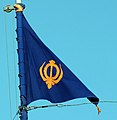নিশান সাহিব

| |
| নিশান সাহিব (আধুনিক সংস্করণ) | |
| অঙ্কন | মধ্যস্থলে খণ্ড চিহ্ন সম্বলিত ত্রিকোণাকৃতির কমলা বা গেরুয়া রঙের পতাকা। |
|---|---|
| শিখধর্ম |
|---|
 |
নিশান সাহিব (টেমপ্লেট:Lang-pan) হলো শিখধর্মের প্রতীক হিসাবে ব্যবহৃৎ ত্রিকোণাকৃতির পতাকা যা সুতি বা সিল্কের কাপড় দিয়ে তৈরি করা হয় এবং এর শেষ প্রান্তে ঝাল্লা দেয়া থাকে। বর্তমানে সারা পৃথিবীর গুরুদ্বারগুলোতে ব্যবহৃৎ নিশান সাহিবটির বর্ণ কমলা (সাফরণ) এবং খণ্ড চিহ্নটি এর কেন্দ্র ভাগে স্থাপিত। এটি গুরুদ্বারের বাহিরের একটি দীর্ঘ পতাকাদণ্ডের ওড়ানো হয়।[১]
বিবরণ[সম্পাদনা]

পতাকাটি অধিকাংশ গুরুদ্বারের বাহিরে একটি দীর্ঘ দণ্ডে টানানো হয়। পতাকাদণ্ডটিও একই বর্ণের বস্ত্র দ্বারা ("চোলা" বলা হয়) আচ্ছাদিত থাকে যেন পতাকাটি ভালোভাবে প্রদর্শিত হয়, সর্বোচ্চ প্রান্তে একটি খণ্ড (পূর্বে একটি অষ্টভুজ, নগ্ন বর্শা বা তীর দেয়া থাকতো) থাকে।[১] পতাকায় থাকা প্রতীকটি খণ্ড নামে পরিচিত যেটি পতাকার কেন্দ্রে থাকে ও দুই দিক ধারালো খণ্ড নামক তলোয়ার (মিরি তে পিরি) (☬) চিত্র, একটি বৃত্তাকার চক্কর এবং দুটি একপার্শ্ব ধারালো তলোয়ার (কৃপাণ) দ্বারা বেষ্টিত থাকে।[১]
অষ্টাদশ শতকের প্রায় সকল শিখ যোদ্ধা এটি পরিধান করতো। খণ্ড সাহিব নিশানের সাথে একীভূত নয়, খণ্ড হলো খালসাদের প্রধান প্রতীক। খালসা পন্থীদের নিশান সাহিব অনেক দূর থেকে দৃষ্টিগোচর হয়; যার দ্বারা সন্নিহিত অধিবাসীদের অবগত করানো হয় খালসাদের অবস্থান। প্রতি বৈশাখীতে (শষ্য উৎসব, গ্রেগরিয়ান পঞ্জিকা অনুসারে মধ্য এপ্রিল ও নানকশাহী পঞ্জিকা অনুসারে বৈশাখ মাস) এটি নামানো হয় এবং নতুন আরেকটি দিয়ে প্রতিস্থাপন করা হয় ও পতাকাদণ্ডটিও পরিবর্তন করা হয়।
ইতিহাস[সম্পাদনা]
গুরু অমর দাশ[সম্পাদনা]
গুরু অমর দাশের সময় গোইন্দওয়ালে বিয়াস নদীর তীরে নবনির্মিত বাউলি সাহিবে একটি সাদা-ত্রিকোণাকৃতির পতাকা ওড়ানো হতো।[২][৩][১][৪] এই সাদা পতাকাটিকে ধবল ধ্বজা ('সাদা ব্যানার') বলা হতো।[২]
চিত্রশালা[সম্পাদনা]
-
Illustrated folio of a Nishan Sahib from a Guru Granth Sahib manuscript housed at Takht Keshgarh Sahib, Anandpur and dated to 1714
-
হরমন্দির সাহিবে উড্ডীন নিশান; আনু. ১৮৪০ খ্রি.।
-
Nishan Sahib in blue, at Akali Phoola Singh di Burj in Amritsar
-
Basanti Nishan Sahib, as introduced by SGPC[তথ্যসূত্র প্রয়োজন]
-
ca.1820 fresco from Harmandir Sahib showing Nishan with Katar (dagger), Dhal (shield), and Kirpan (sword)
-
Sikh Basanti (yellow) Nishan Sahib (flag) as introduced by Guru Hargobind[তথ্যসূত্র প্রয়োজন]
-
Sikh Nihang Khalsa Fauj Flag, introduced by Guru Gobind Singh
-
Flag used during the times of Sikh misls and the Sikh Empire[তথ্যসূত্র প্রয়োজন]
-
19th century painting depicting Guru Gobind Singh with followers carrying Basanti flag with emblems
-
রণজিত সিংজী কর্তৃক ব্যবহৃত শিখ সাম্রাজ্যের নিশান সাহিব পতাকা।
-
বর্তমানে ব্যবহৃত নিশান সাহিব।
-
Flag of the Nihang Khalsa Fauj showing weapons like Katar (dagger), Dhal Shield and Kirpan. The standard goes from 'bottom to top' signifying that the armies of the tenth guru are always victorious.[তথ্যসূত্র প্রয়োজন]
-
Illuminated Guru Granth Sahib folio of a Nishan, আনু. ১৭৭৫ খ্রি. with red background, thin gold borders, and central motif of a tulwar sword and dhal shield. কাগজে অঙ্কিত, পাঞ্জাব।
তথ্যসূত্র[সম্পাদনা]
- ↑ ক খ গ ঘ Singh, Pashaura (২০১৯)। A Dictionary of Sikh Studies। Oxford Quick Reference। Oxford University Press। আইএসবিএন 9780192508430।
Mostly, it is triangular in shape and saffron in colour. Nihangs usually have dark-blue-coloured flags in their gurdwaras. The mast is always draped in cloth of the same colour, called chola. The Khalsa emblem of Khanda is embroidered or printed on the flag, and a steel spear, a two-edged sword, or another Khanda surmounts it. The tradition of mounting a 'white flag' (dhaval dhuja) at the Sikh centre on the bank of the Beas River began at Goindval during the period of Guru Amar Das (GGS 1393). It gave the message of peace and welfare of all. After Guru Arjan's martyrdom the colour of the flag became saffron, symbolizing sacrifice. Guru Hargobind put the symbols of two swords of temporal (miri) and spiritual (piri) authority on the flag he mounted in front of the newly built Akal Takhat. The protest march (chaunki charhni) established by Baba Buddha and Bhai Gurdas from the Akal Takhat to the Gwalior fort during the imprisonment of the sixth Guru had the Sikh flag carried in front by a standard-bearer (nishanchi) alongside a torchbearer (mishalchi). After the creation of the Khalsa in 1699, the imprints of 'cooking vessel or cauldron' (deg) and 'sword' (teg) were put on the flag to highlight the Khalsa ideal of providing food and justice to all. During the rule of Maharaja Ranjit Singh, each regiment of the Khalsa army had its own particular flag. The modern standard form of Nishan Sahib came about as the result of Singh Sabha reforms.
- ↑ ক খ Kulim, Gurcharan Singh (৫ অক্টোবর ২০১২)। "The Sikh Flag ~ Nishan Sahib"। SikhNet। সংগ্রহের তারিখ ৬ সেপ্টেম্বর ২০২৩।
- ↑ Singh, Pashaura (২০০৬)। Life and Work of Guru Arjan: History, Memory, and Biography in the Sikh Tradition। Oxford University Press। আইএসবিএন 9780199087808।
He [Bhai Gurdas] also points towards the existence of a flag (nishan) at the Sikh court (divan). In fact, the tradition of mounting a white flag (dhaval dhuja) had already begun at Goindval during the period of Guru Amar Das. Presumably, the colour of the Sikh flag at Darbar Sahib was also white, standing for the message of peace and goodwill and leading new visitors to the Sikh place of worship.
- ↑ Singh, Pashaura; Mandair, Arvind-Pal Singh (২০২৩)। The Sikh World। Routledge Worlds। Taylor & Francis। আইএসবিএন 9780429848384।
For the first time the third Guru mounted a "white flag" (dhaval dhuja) at the central place of Goindval, giving the message of peace and prosperity to his audience (GGS 1393).






![Basanti Nishan Sahib, as introduced by SGPC[তথ্যসূত্র প্রয়োজন]](http://upload.wikimedia.org/wikipedia/commons/thumb/f/f5/Real_Nishan_Sahib.png/120px-Real_Nishan_Sahib.png)

![Sikh Basanti (yellow) Nishan Sahib (flag) as introduced by Guru Hargobind[তথ্যসূত্র প্রয়োজন]](http://upload.wikimedia.org/wikipedia/commons/thumb/8/8e/Sikh_Basanti.svg/120px-Sikh_Basanti.svg.png)

![Flag used during the times of Sikh misls and the Sikh Empire[তথ্যসূত্র প্রয়োজন]](http://upload.wikimedia.org/wikipedia/commons/thumb/e/e0/Kattar_Dhal_Talwar.png/120px-Kattar_Dhal_Talwar.png)



![Flag of the Nihang Khalsa Fauj showing weapons like Katar (dagger), Dhal Shield and Kirpan. The standard goes from 'bottom to top' signifying that the armies of the tenth guru are always victorious.[তথ্যসূত্র প্রয়োজন]](http://upload.wikimedia.org/wikipedia/commons/thumb/5/59/Sikh_flag.jpg/120px-Sikh_flag.jpg)
